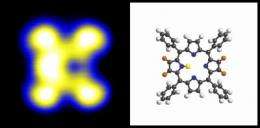The smallest conceivable switch: Targeted proton transfer within a molecule

For a long time miniaturization has been the magic word in electronics. Dr. Willi Auwaerter and Professor Johannes Barth, together with their team of physicists at the Technische Universitaet Muenchen (TUM), have now presented a novel molecular switch in the journal Nature Nanotechnology. Decisive for the functionality of the switch is the position of a single proton in a porphyrin ring with an inside diameter of less than half a nanometer. The physicists can set four distinct states on demand.
Porphyins are ring-shaped molecules that can flexibly change their structure, making them useful for a wide array of applications. Tetraphenylporphyrin is no exception: It likes to take on a saddle shape and is not limited in its functionality when it is anchored to a metal surface. The molecule holds has a pair of hydrogen atoms that can change their positions between two configurations each. At room temperature this process takes place continuously at an extremely rapid rate.
In their experiment, the scientists suppressed this spontaneous movement by cooling the sample. This allowed them to induce and observe the entire process in a single molecule using a scanning tunneling microscope. This kind of microscope is particularly well suited for the task since – in contrast to other methods – it can be used not only to determine the initial and final states, but also allows the physicists to control the hydrogen atoms directly. In a further step they removed one of the two protons from the inside of the porphyrin ring. The remaining proton could now take on any one of four positions. A tiny current that flows through the fine tip of the microscope stimulates the proton transfer, setting a specific configuration in the process.
Although the respective positions of the hydrogen atoms influence neither the basic structure of the molecule nor its bond to the metallic surface, the states are not identical. This small but significant difference, taken together with the fact that the process can be arbitrarily repeated, forms the basis of a switch whose state can be changed up to 500 times per second. A single tunneled electron initiates the proton transfer.
The molecular switch has a surface area of only one square nanometer, making it the smallest switch implemented to date. The physicists are thrilled by their demonstration and are also very happy about new insights into the mechanism behind the proton transfer resulting from their study. Knud Seufert played a key role with his experiments: "To operate a four-state switch by moving a single proton within a molecule is really fascinating and represents a true step forward in nano-scale technologies."
More information: Willi Auwaerter, Knud Seufert, Felix Bischoff, David Ecija, Saranyan Vijayaraghavan, Sushobhan Joshi, Florian Klappenberger, Niveditha Samudrala, and Johannes V. Barth, A surface-anchored molecular four-level conductance switch based on single proton transfer, Nature Nanotechnology, Advance Online Publication, 11 December 2011 DOI:dx.doi.org/10.1038/NNANO.2011.211
Journal information: Nature Nanotechnology
Provided by Technische Universitaet Muenchen


















